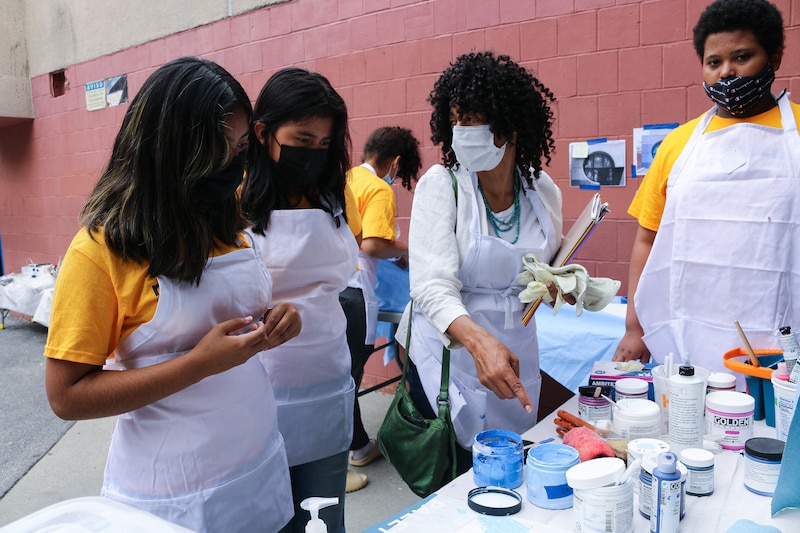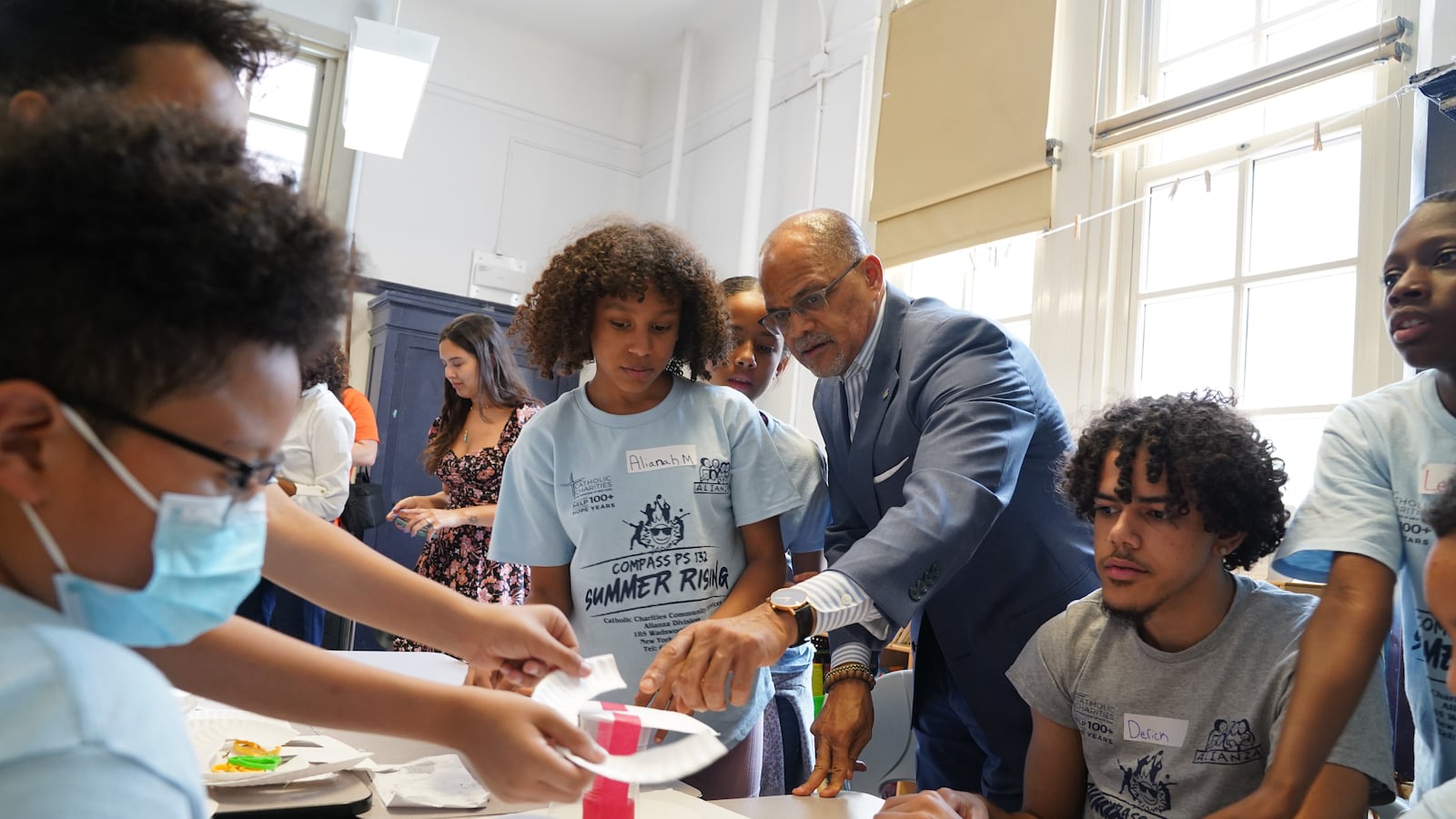Sign up for Chalkbeat New York’s free daily newsletter to keep up with NYC’s public schools.
Since launching Summer Rising in 2021, New York City officials have frequently pointed to the large number of applications as evidence of the program’s success. But attendance numbers tell a very different story.
This year, roughly 138,000 elementary and middle school kids applied for 110,000 available seats in the free program spawned during the pandemic. Its combination of academics and camp-like activities aimed to reconnect students to school — and each other — after remote learning. For the first time, summer school was no longer just for students who were failing classes. That reduced its stigma.
In fact, once it began, parents clamored for it, and the city kept it going, ponying up city dollars this year to cover the costs after federal COVID stimulus funding dried up. Schools Chancellor David Banks said the program has become a “cornerstone in the lives of our youngest New Yorkers.”
Yet on an average day in 2022 and 2023, only about 60% of students enrolled in Summer Rising actually showed up to the academic portion of the day, which is overseen by the Education Department, according to agency figures obtained by Chalkbeat that haven’t previously been publicly reported. Officials didn’t share numbers for this summer but said attendance so far is “on par” with past years.
The ongoing attendance challenges are raising questions about whether the program — which costs $240 million a year — is the best use of city resources, and whether an initiative designed during the height of the pandemic is still the right approach. Low attendance has made it difficult for program operators to plan staffing, among other practical challenges, and raises questions for some educators about whether Summer Rising is meeting families’ needs.
Education Department officials attributed the anemic attendance to the optional nature of its free summer programming. Only a fraction of the attendees are mandated to attend Summer Rising for academic reasons. So it might not come as a surprise that the program’s daily attendance is dramatically lower than during the school year, which averaged between 88% and 89% in 2022 and 2023.
But interviews with more than a dozen principals, community-based organizations, families, and experts indicate that specific features of Summer Rising may be contributing to the attendance shortfalls.
“We’re not even evaluating to see if it’s doing the things that we want it to do,” said Bronx City Council Member Althea Stevens, the chair of the Council’s Committee on Children and Youth and a former youth services provider.
Stevens, along with some principals and program operators, argue that the city should return to the pre-COVID system, in which the Department of Youth and Community Development, or DYCD, offered free summer camps for an estimated 90,000 students — including more than 500 camps located in public schools for around 60,000 kids — while schools ran summer classes for kids who failed courses during the school year.
Prior to COVID-19, DYCD’s summer camps cost an estimated $61 million a year, according to United Neighborhood Houses, an organization that lobbies on behalf of nonprofit youth services providers. Last year, the city allocated $150 million for just the DYCD portion of Summer Rising, according to city budget officials.
Others fiercely defend the Summer Rising model.
Students’ COVID academic losses “are far from recovered,” said Steven Wilson, the cofounder and CEO of the National Summer School Institute, an organization that developed the summer school curriculum now used in roughly two-thirds of Summer Rising sites.
“The most caring thing we can do is make sure they have additional instruction — very high quality and very engaging instruction,” he said.
Education Department spokesperson Jenna Lyle called Summer Rising a “vital” program for families, saying, “We’re immensely proud that Summer Rising provides such essential supports to our families that need it the most.”
Attendance woes driven by range of factors
Educators and summer camp operators acknowledged that underwhelming attendance often comes with the territory of running free summer programs, where attendance is generally not mandatory and families aren’t on the hook financially.
“I don’t know how to fix the problem,” said one principal who runs a Summer Rising program, who spoke on the condition of anonymity because they’re not authorized to talk to the media. “A fair number of parents sign up and either decide to do something else, or kids talk them into doing something else.”
Even so, multiple Summer Rising nonprofit partners said they routinely saw higher attendance in the summer camp programs they previously ran, which didn’t have a designated academic portion.
A spokesperson for DYCD said attendance in school-based summer camps in 2019 averaged 69%, compared to 60% attendance for Summer Rising for the past three years.
The first four hours of the Summer Rising day are purely academic, a turnoff for some families seeking a more recreational experience. Parents of children with disabilities have consistently reported challenges getting accommodations for their kids. And logistical snags, including sparse communication with parents, a lack of field trips, and placements far from home, have kept some kids away, families, and educators said.
Mike Halpern, the assistant executive director of Mosholu Montefiore Community Center, a summer camp operator that runs 16 Summer Rising sites in the Bronx and Manhattan, said that when the Department of Youth and Community Development “let us do whatever we wanted … the kids would come more than they do now.”

The lagging attendance can make it difficult to know how many teachers to hire and lead to inconsistent class sizes, several principals said.
Schools are supposed to follow up with families whose kids aren’t regularly attending, disenroll those who aren’t attending at all, and pull in students from the waitlist when possible. An Education Department spokesperson said students are supposed to be removed from the program following six consecutive absences and three outreach attempts. But outreach can be difficult in a program that only lasts six weeks.
When Kiri Soares, the principal of the Urban Assembly Institute of Math and Science for Young Women in downtown Brooklyn, ran her own summer school program prior to the pandemic, she made sure her kids showed up.
“They knew me, they knew my staff, we did the outreach,” she said.
But now, Soares runs a Summer Rising site filled mostly with families from other schools who she doesn’t know. That means just tracking down the families can take weeks, by which time the program is almost over, she said.
Academic focus divides families, educators
The dedicated time for academics — Summer Rising’s defining feature — has proved one of its most controversial.
Proponents say the program is helping. Students across roughly 126 Summer Rising sites using the National Summer School Institute curriculum in 2023 improved by an average of 15 percentage points on a literature test from the beginning to the end of the summer, and by 24 percentage points on a pre- and post-math test, according to figures compiled by the organization.
“I noticed it helped a lot,” said Shantel Andrews, the mother of an elementary student with a disability currently attending a Summer Rising program in Crown Heights, Brooklyn. “I fought for her to get in this year. I stayed up late. I’m glad I got her in.”
Some educators say that expanding summer school beyond kids who are required to attend has been most helpful to the students who have to be there. They say it helps them to be in classrooms with kids at other academic levels.
Others have found the opposite, arguing it’s harder to target support for kids who need it when they’re in larger, more heterogeneous groups.
For Michelle, a Brooklyn parent whose third grader got a spot in Summer Rising for the first time this year, the academic portion of the program was a major turnoff, and far less engaging than she expected.
“My child was very unhappy and cried when I picked her up the first day,” recalled Michelle, who asked to use only her first name because she works in education and is concerned about professional consequences. “She said, ‘this is school.’”
Michelle said she doesn’t mind some academic enrichment as part of a summer program, but “to have kids sit in a classroom with workbooks and tablets and call that enrichment … it’s not thoughtful.”
Eventually, Michelle decided to only send her daughter three days a week — even though she could go five days a week.
For families of the roughly 20% of city students who are mandated to receive special education services, reviews of Summer Rising are mixed.
The Education Department allocates each Summer Rising program between $5,200 and $6,600 to hire two education paraprofessionals to support students with disabilities, according to budget documents. There are more specialized programs with additional resources for students with 12-month Individual Education Programs, or IEPs.
Paul Trust, a Queens parent and public school teacher who’s previously had concerns about the academic focus of Summer Rising, said the program has been especially helpful for his child with a disability: “She came into September as the only student who came into school having gone up in reading.”
But Lupe Hernandez, a Manhattan parent of an 11-year-old with a disability who is entitled to year-round support through his IEP, was unhappy about the lack of school bus service in the evenings. And on his first day, a lack of planning left him sitting in a cafeteria for several hours.
In fact, she was so frustrated by his experience after that first day that even though he’s still technically enrolled, she hasn’t sent him back since.
Some push for return to pre-COVID camp system
Halpern, the Bronx Summer Rising camp operator, attributes his programs’ relatively high attendance — which he says hovers in the mid-70% range — to the weekly field trips to nature camps in Harriman State Park in the Catskills.
But Halpern has a notable edge: His organization owns the summer camps, making it possible to bring each of the 16 Summer Rising programs at least one day a week.
“The kids really, really enjoy the outdoors,” he said, “far away from the school yard environment.”
Other parents say their Summer Rising programs have struggled to consistently offer the frequently advertised once-a-week field trips, giving few if any chances to get outside the school.
Several program operators said it can be much more challenging to plan more intensive or elaborate recreational activities when they get so much less time with kids than they did in the previous summer camp system.
“There’s a little bit of a disconnect and misalignment with the curriculum educators are using in the morning … to what’s happening later in the afternoon with the CBOs,” said Jennifer Zweifler, an associate director with St. Nick’s Alliance who oversees three Summer Rising programs in Brooklyn.
In a “perfect world,” the city would return to the pre-COVID summer camp system, while still recruiting public school teachers to offer extra academic support, Zweifler said.
Soares, the Brooklyn principal, said “the crisis and the learning loss” that prompted the city to launch Summer Rising are still very real. But the attendance numbers should tell city officials that they need to rethink the program, she said.
“We’re facing a real dilemma of convincing kids and families that school is even worth going to,” she said. “Summer is wasted to be re-doing the form of learning [students do] all year long.”
Michael Elsen-Rooney is a reporter for Chalkbeat New York, covering NYC public schools. Contact Michael at melsen-rooney@chalkbeat.org .

